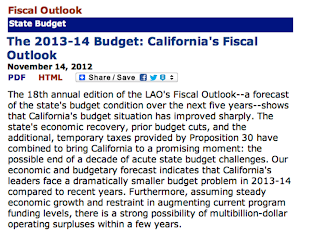 |
"Proposition 30 win no guarantee of fiscal safety for California"
Los Angeles Times, November 11, 2012
|
One thing that I've been thinking about the past few days is, what, exactly, will California's budget look like, in, say, 2014. California's budget is anything but simple, but people generally discuss the General Fund when they're talking about "the budget." It's around $91 billion. The estimated shortfall is $16 billion. Here's an example of an LA Times article that demonstrates the practice of referring to the General Fund as "the budget."
If you ask the California Department of Finance the same question, though, they'll tell you the budget is about $225 billion.
The difference between $91 billion and $225 billion is kind of a lot of money.
 |
"Historical Data / Budget Expenditures"
California Department of Finance,
|
The most significant item ignored in California's budget discussion are the federal funds spent by the State. That number has increased by about $50 billion in the last ten years, to where it now nearly equals the entire General Fund. That's a massive change; between 2004-2008, the Federal Funds were about half of the size of the General Fund.
To be sure, the massive increase in Federal Funds reflects a very unusual economy, including things like unemployment payments when the State's been dealing with 12% unemployment. But the economic problem is immediate for California; the long term problem is health care.
The Department of Finance's web site is great for throwing light on these kinds of questions. I've pulled up the line item for Health and Human Services, and then the specific line item for Medi-Cal. The fact that Medi-Cal is a single line item on the spreadsheet must make staffers at DoF laugh on an annual basis -- there's a thousand lines that are minnows, and then there's this whale trying to hide in the middle.
 |
"Comparative Statement of Expenditures"
(the Medi-Cal Line Item)
California Department of Finance,
|
There are a couple of points to take away from this. First, California actually cut spending on Medi-Cal in 2012, by about 3%, even when Federal Money is included. That may not sound like much,
but it is unprecedented in recent history. The "good news" is expected to end in 2013, when spending is anticipated to return to its trend line, and California will spend $56.6 billion on health care. The General Fund's share of that is expected to be the same (about $15 billion) but $6 billion in Special Funds were expected to show up -- which, they duly have, due to the passage of Proposition 30.
Of course, the idea that there is a State program getting larger is amazing in and of itself, because every other program has been facing budget
cuts.
 |
"California to Lose Big if Supreme Court Scraps U.S Health Care Law"
Los Angeles Times, June 20, 2012
|
But the interesting number is the one that's not on this spreadsheet - the numbers that are expected for 2014. While Federal Funds are already a larger part of the Medi-Cal line item than the entire State expenditure, it appears that the Federal Funds are about to increase by approximately $15 billion, due to the Affordable Care Act, also known as "Obamacare" -- an amount equal to the entire "budget" contribution to Medi-Cal, and an amount that's also roughly equal to the shortfall that's caused so much consternation in the last year.
It's impossible to say what consequences of ACA ("Obamacare") funding will be for the General Fund, because facts on the ground are now changing quite fast. I think it's reasonable to expect a very significant amount will be heading to education, due to the effects of Prop 98 and its progeny.
 |
Michael Montgomery, "California Prisons Are Still Overcrowded"
East Bay Express, November 7, 2012
|
I think the hope is that the Democratic supermajority, coupled with defeat of staunch labor champions at the ballot box (
Michael Allen, you fought the good fight but it's probably time to concede defeat ...), means that, while the actions by the legislature in response are unpredictable, they will at least be
different than those taken by the legislature between 1999-2001.
The wild card, though, I think, is the State's prison overcrowding situation. While the State's realignment (basically, shifting state prison inmates to the county jails) has made some progress towards complying with U.S. District Court Judge Thelton Henderson's order, I don't think there's really room for dispute that the State continues to fail to meet its obligations.
One wonders how much patience Judge Henderson will (or should) have for the State and its claims that it cannot afford to comply completely, if the State undertakes new high-speed rail spending or begins aqueduct construction projects. The functioning of the justice system requires a proper prison system, which is an issue that, one suspects, could engender bipartisan support, even if it is not immediately politically rewarding.















